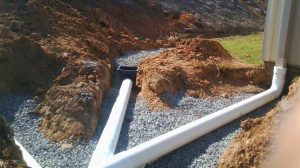French Drain Orlando

In theory French drain should rid your yard of unwanted water when certain site conditions exist. Do you have pooling water that collects around your home? How about a drainage problem around the perimeter of your house that causes moisture to eat away at the foundation of your home? The solution to these problems could be a French drain, which sounds like a simple solution. In the state of Florida where we have a flat terrain and a high water table that fluctuates with rainfall and changing tides, a French drain is not an effective solution.
The French drain takes its name from its inventor, a Massachusetts farmer named Henry French, who built the first one in 1859. It’s basically an underground drainage system consisting of a sloping trench filled with gravel and a perforated drain pipe and covered with drain rock and landscape fabric. It collects water from places where you don’t want it and channels it to a location from where it can safely run off, be absorbed into the ground soil, or be pumped away. French drains can sometimes be the answer, but often times they are not an adequate solution.
French Drain Installation Orlando

Pools of standing water that form in yards with large depressions or poorly draining soil can create all kinds of problems. Standing water provides breeding areas for mosquitoes, it drowns vegetation and basically makes that part of the yard unusable. Installing a French drain can be an effective way to channel the water to another part of the yard, to the street or to a dry well. This type of drain is known as a shallow French drain or a curtain drain.
A shallow drain consists of a modestly sized trench about 12 inches wide and dug to a depth between 12 and 24 inches. The trench should have a minimum downward slope of about 1 inch per 8 feet toward the area where you want to direct the water. Line the trench with landscape fabric, fill the bottom with gravel, set a 3-inch perforated drain pipe on the gravel, and backfill with drain rock. Fold the landscape fabric over the drain rock, cover with topsoil and plant grass, and no one will know the drain is there.
It’s common to locate a shallow French drain at a slightly higher elevation than the depression in which the water collects. That way water headed for the depression flows into the drain instead, and the pool of standing water disappears and doesn’t return. In order for a French Drain to work properly, it has to be installed above the water table.

